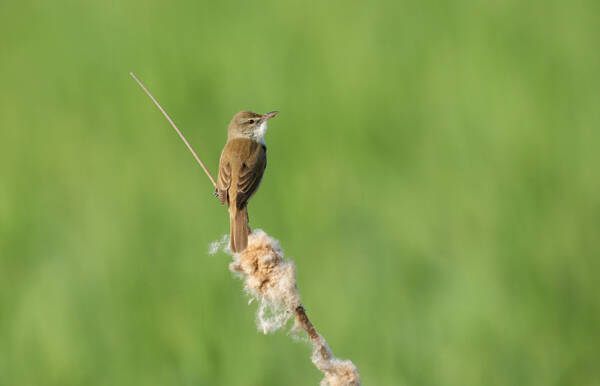Acrocephalus orientalis
IUCN
LCBasic Information
Scientific classification
- name:Acrocephalus orientalis
- Scientific Name:Acrocephalus orientalis,Reed strings, quacking, splitting reeds, chirping
- Outline:Songbird
- Family:Passeriformes Ornithogalidae R.Warbler
Vital signs
- length:24-34g
- Weight:164-198mm
- lifetime:
Feature
A slightly larger brown reed warbler with prominent yellow eyebrow lines.
Distribution and Habitat
It is widely distributed in the eastern, central and northern regions of China, and passes through South China, Hainan Island and Taiwan Island during migration. It is found abroad in Northeast Asia, South Asia, Southeast Asia, the Philippines and Indonesia.
The Oriental Great Reed Warbler mainly inhabits low mountains, hills and plains at the foot of mountains below 900 meters above sea level. It often appears in lakes, rivers, ponds, streams, reservoirs, river banks, reed marshes and other waters or near waters. There are densely covered swamps and wet grasslands in reeds and willow bushes.
Appearance
The upper body is olive brown, the lower body is creamy yellow. The eyebrow is yellow, the throat is light, the chest has slight vertical stripes, and the flanks are brown. It is smaller than the Great Reed Warbler and is distinguished from it by the vertical stripes on the chest. The iris is brown, the upper bill is brown, the base of the lower bill is light, and the feet are gray-brown.
Details
Oriental Great Reed Warbler is a summer migratory bird in China, and some are resident birds. In spring, they migrate to China to breed from early May to mid-to-late May, and in autumn, they begin to migrate from their breeding grounds to their wintering grounds in late September and early October.

They often move alone or in pairs, are lively, and often jump and climb between grass stems or bushes. When people approach them, they are extremely alert, constantly changing positions or suddenly disappearing, and then suddenly appearing in another place. Often sing loudly, the sound is like: "ga-ga-ji". During the breeding period, it often sings on the top of the reeds near the nest or on the nearby branches. Sometimes it moves for a while, sings for a while, or moves around while singing. The sound is crisp and sharp. In winter, it only intermittently emits a hoarse, panting single note "chack". Active in reed fields.
It mainly feeds on beetles, golden flower beetles, Lepidoptera larvae, as well as insects such as ants, damselflies and aquatic insects. It also eats other invertebrates such as spiders and snails and a small amount of plant fruits and seeds.

The breeding season is from late May to late July. Usually nests are built in bushes or willow bushes near waterside and water areas. The nests are mostly built on the branches of bushes and small trees. They also build nests on the stems of reeds and water plants in reed ponds. The nests are located in well-ventilated reed fields. The nests are 0.8-1.6 meters above the ground. The nests are built between the reed stems by pulling 3-4 thick reed stems close together with thin reed stems, reed leaves and other plant fibers. The nest is a deep cup-shaped nest, which is made of these stems, leaves and reed spikes; the nest is padded with dry reed leaves, reed spikes, down, animal hair, etc. The measurements of the nest are: outer diameter 10-12 cm, inner diameter 7-8 cm, height 10-13 cm, depth 6.0-7.5 cm. The female bird builds the nest, and the male bird accompanies it. There are 4-6 eggs in the nest, and there are also 3 eggs. The eggs are oval, light blue-green, gray-white or duck egg blue, with brown or purple-brown spots on them. The size of the eggs is uneven, with an average size of 16.3 mm × 30 mm. The nest will only sit in the nest to incubate the eggs after the nest is full of eggs. The female bird incubates the eggs, and sometimes the male bird is seen feeding them. The incubation period is 11-13 days. The chicks have a low and unstable body temperature, and the female bird often lies in the nest to keep warm. As the age increases, the constant temperature mechanism is gradually established. When the body temperature is constant and reaches the body temperature of the adult bird, it begins to leave the nest. Newly hatched chicks are naked and featherless, weighing only about 2.5 grams. The male and female parents share the responsibility of raising the chicks. After about 19 days of feeding, the chicks can leave the nest and fly away.
Listed in the "Red List of Endangered Species of the World Conservation Union" (IUCN) 2016 ver 3.1-Least Concern (LC).








